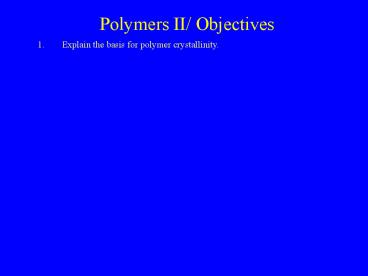Polymers II/ Objectives PowerPoint PPT Presentation
1 / 49
Title: Polymers II/ Objectives
1
Polymers II/ Objectives
- Explain the basis for polymer crystallinity.
2
Polymers II/ Objectives
- Explain the basis for polymer crystallinity.
- Explain the effects of crystallinity on physical
and mechanical properties.
3
Polymers II/ Objectives
- Explain the basis for polymer crystallinity.
- Explain the effects of crystallinity on physical
and mechanical properties. - Explain the mechanisms underlying elastic,
viscoelastic, and plastic deformation in polymers.
4
Polymers II/ Objectives
- Explain the basis for polymer crystallinity.
- Explain the effects of crystallinity on physical
and mechanical properties. - Explain the mechanisms underlying elastic,
viscoelastic, and plastic deformation in
polymers. - Identify the regions of behavior on a TS
Modulus/Temperature curve.
5
Polymers II/ Objectives
- Explain the basis for polymer crystallinity.
- Explain the effects of crystallinity on physical
and mechanical properties. - Explain the mechanisms underlying elastic,
viscoelastic, and plastic deformation in
polymers. - Identify the regions of behavior on a TS
Modulus/Temperature curve. - Explain the mechanism of temperature and rate
dependence of polymer modulus, and yield.
6
Polymers II/ Objectives
- Explain the basis for polymer crystallinity.
- Explain the effects of crystallinity on physical
and mechanical properties. - Explain the mechanisms underlying elastic,
viscoelastic, and plastic deformation in
polymers. - Identify the regions of behavior on a TS
Modulus/Temperature curve. - Explain the mechanism of temperature and rate
dependence of polymer modulus, and yield. - Summarize the major environmental variables which
impact polymer failure in TPs and TSs.
7
Polymers II/ Objectives
- Explain the basis for polymer crystallinity.
- Explain the effects of crystallinity on physical
and mechanical properties. - Explain the mechanisms underlying elastic,
viscoelastic, and plastic deformation in
polymers. - Identify the regions of behavior on a TS
Modulus/Temperature curve. - Explain the mechanism of temperature and rate
dependence of polymer modulus, and yield. - Summarize the major environmental variables which
impact polymer failure in TPs and TSs. - Describe the basic mechanisms of failure in TP
and TS polymers.
8
Physical Properties of Polymers
- Non conducting - electrically
- (except polyacetylene)
9
Physical Properties of Polymers
- Non conducting - electrically
- (except polyacetylene)
- 2. Good thermal insulators
10
Physical Properties of Polymers
3. Free volume varies with temp
11
Physical Properties of Polymers
- Non conducting - electrically
- (except polyacetylene)
- 2. Good thermal insulators
- 3. Free volume varies with temp
- 4. Optically crystalline/ semi-crystalline
12
Heat Capacity
- Thermosets
- Amorphous polymers
- Tg cure exotherm
13
Heat Capacity
Semi-crystalline polymers Tg weak Crystallizatio
n exotherm Melting - endotherm
14
Heat Capacity
General Water vaporization endotherm Additive
vapor endotherm Decomposition - exotherm
15
Glass Transition Temp.
- Breakdown of Van Der Waals Forces
16
Glass Transition Temp.
- Breakdown of Van Der Waals Forces
- Onset of large scale molecular motions
17
Glass Transition Temp.
- Breakdown of Van Der Waals Forces
- Onset of large scale molecular motions
- Important in amorphous polymers
18
Glass Transition Temp.
- Breakdown of Van Der Waals Forces
- Onset of large scale molecular motions
- Important in amorphous polymers
- Upper service temperature
19
Modulus Temperature
20
Effect of Crosslinking on Modulus
21
Complex Modulus E (t) E (t) i E (t) E
Storage Modulus (elastic) E Loss
Modulus (viscous dissipation)
22
Transitions from Tan ? E/E
TG
Tan ? E/E
?
?
?
Tallest is TG
23
Tg in Semicrystalline Polymers
- May show where brittle behavior begins
24
Tg in Semicrystalline Polymers
- May show where brittle behavior begins
- Not a predictor of service temperature
25
Tg in Semicrystalline Polymers
- May show where brittle behavior begins
- Not a predictor of service temperature
- Crystals maintain high E SY
26
(No Transcript)
27
(No Transcript)
28
(No Transcript)
29
(No Transcript)
30
(No Transcript)
31
(No Transcript)
32
(No Transcript)
33
Fracture Processes
- 1. Two Deformation Process for Thermoplastics
- Crazing
- (amorphous material )
- Shear Yielding
34
Craze Process Zone
35
Fracture Process Zone PE
36
Ductile Thermoplastic Fracture at Different
Strain Rates
A
B
C
37
(No Transcript)
38
Fracture Processes
2. Thermoset Deformation Process a. Crazing
suppressed b. Shear Yielding only option
39
Fracture Processes
3. Fatigue a. Macroscopically brittle b. Same
mechanisms c. Viscoelasticity complicates picture
40
(No Transcript)
41
(No Transcript)
42
Effect of 2nd Phase Tougheners
43
Environmental Effects on Polymers
- Permeable to many gases H2O vapor
44
Environmental Effects on Polymers
- Permeable to many gases H2O vapor
- Inorganic Acids Bases fairly resistant
45
Environmental Effects on Polymers
3. Organic Solvents can be very
sensitive -Crosslinks, crystallinity improves
resistance -Polarity of polymer solvent
important -Solvents swell, dissolve, crack
polymers
46
Environmental Effects on Polymers
- 4. Moisture absorption
- -Polar polymers (PC, Nylon)
- -lowers modulus and yield strength
- -problem in processing
47
(No Transcript)
48
Environmental Effects on Polymers
5. UV Visible light -Chain scission -UV
stabilizers may be added
49
Environmental Effects on Polymers
- 6. Heat
- -Chemical Aging
- -Physical Aging

